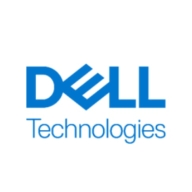


Dell PowerMax and IBM FlashSystem 9100 NVMe compete in the high-performance storage solutions market. Dell PowerMax holds an edge due to its comprehensive data reduction capabilities and renowned reliability.
Features: Dell PowerMax offers advanced deduplication, compression, NVMe-based technology, SRDF replication capabilities, and noteworthy reliability. IBM FlashSystem 9100 NVMe features FlashCore modules, easy deployment, and consistent performance alongside robust backup and recovery options.
Room for Improvement: Dell PowerMax could benefit from enhanced deduplication and compression ratios, improved NVMe features, and better management tools via RESTful API. IBM FlashSystem 9100 NVMe could expand database integration, refine compression efficiency, and enhance scalability.
Ease of Deployment and Customer Service: Dell PowerMax is deployed predominantly on-premises and is perceived as user-friendly with responsive customer service, although SLA adherence can improve. IBM FlashSystem 9100 NVMe is deployed on-premises with some cloud options, and while it provides solid support, service accessibility could be enhanced compared to Dell.
Pricing and ROI: Dell PowerMax is priced as a premium solution with substantial ROI through workload consolidation and data center efficiency. IBM FlashSystem 9100 NVMe offers a competitively priced solution, considered more cost-effective initially, with operational efficiencies providing considerable value.
| Product | Market Share (%) |
|---|---|
| Dell PowerMax | 9.1% |
| Pure FlashArray X NVMe | 3.3% |
| IBM FlashSystem 9100 NVMe | 1.4% |
| Other | 86.2% |



| Company Size | Count |
|---|---|
| Small Business | 15 |
| Midsize Enterprise | 11 |
| Large Enterprise | 12 |
| Company Size | Count |
|---|---|
| Small Business | 17 |
| Midsize Enterprise | 16 |
| Large Enterprise | 54 |
| Company Size | Count |
|---|---|
| Small Business | 8 |
| Midsize Enterprise | 8 |
| Large Enterprise | 5 |
Pure Storage FlashArray//X is the world’s first enterprise-class, all-NVMe flash storage array. It represents a new class of storage – shared accelerated storage, which is a term coined by Gartner – that delivers major breakthroughs in performance, simplicity, and consolidation.
PowerMax leads in mission-critical enterprise storage with advanced architecture and AI-driven automation, ensuring secure and efficient IT optimization. Its multi-node NVMe scale-out framework delivers unmatched performance and consolidation, backed by Dell’s Future-Proof Program.
PowerMax is renowned for its robust reliability, performance, and efficient data reduction capabilities. Users benefit from its NVMe architecture, aiding significant scalability and cost efficiency through effective deduplication and compression. Unisphere simplifies management, while CloudIQ provides enhanced monitoring. With high availability and strong IOPS capabilities, PowerMax effectively manages demanding workloads and ensures seamless operations. Its compact design and increased storage capacity enhance user experience, particularly with easy maintenance and robust performance.
What are the key features of PowerMax?Dell PowerMax is predominantly employed in mission-critical applications such as SQL, Oracle databases, ERP systems, and high transactional environments. Healthcare, finance, and e-commerce sectors leverage its high performance, scalability, and NVMe technology for low latency and redundancy. It is adept in storage consolidation, data analytics, and disaster recovery.
IBM FlashSystem 9100 combines the performance of flash and Non-Volatile Memory Express (NVMe) end-to-end with the reliability and innovation of IBM FlashCore technology and the rich features of IBM Spectrum Virtualize - all in a powerful 2U enterprise-class storage system. Providing intensive data driven multicloud storage capacity, FlashSystem 9100 is deeply integrated with the software defined capabilities of IBM Spectrum Storage allowing you to easily add in the multicloud solutions that best support your business.
We monitor all NVMe All-Flash Storage Arrays reviews to prevent fraudulent reviews and keep review quality high. We do not post reviews by company employees or direct competitors. We validate each review for authenticity via cross-reference with LinkedIn, and personal follow-up with the reviewer when necessary.